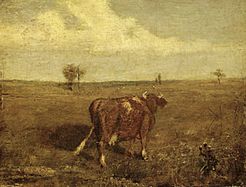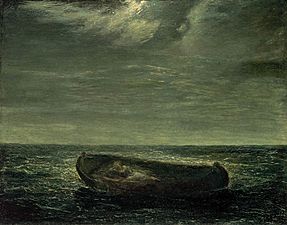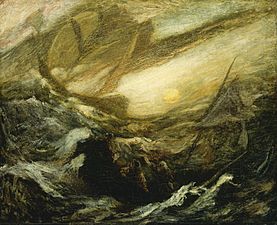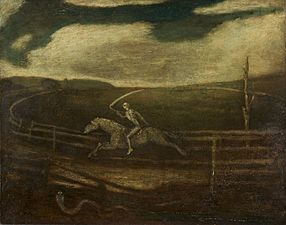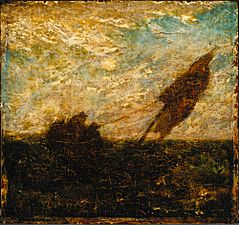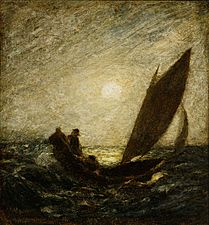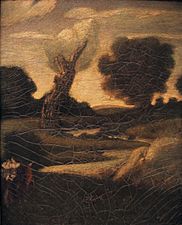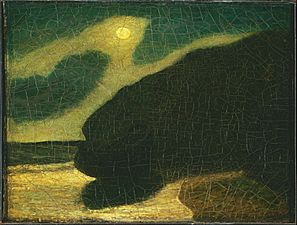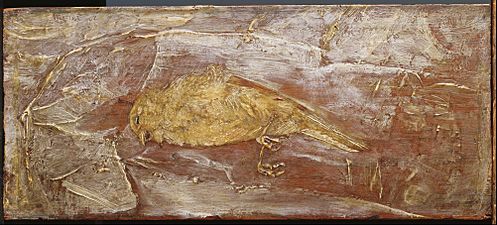Albert Pinkham Ryder facts for kids
Quick facts for kids
Albert Pinkham Ryder
|
|
|---|---|
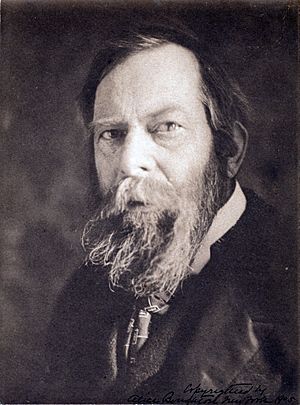
Ryder in 1905, photo by Alice Boughton
|
|
| Born | March 19, 1847 |
| Died | March 28, 1917 (aged 70) New York City, US
|
| Education | National Academy of Design |
| Known for | Painting |
| Movement | Tonalism |
Albert Pinkham Ryder (born March 19, 1847 – died March 28, 1917) was an American painter. He was famous for his unique and dream-like paintings. These often showed stories or scenes from the sea. His art had soft colors, like other "Tonalist" painters of his time. But Ryder's style was special because he focused on shapes in a new way. Some art experts even call his work "modern." He was also known for his unusual personality.
Contents
Early Life and Moving to New York
Albert Pinkham Ryder was born in New Bedford, Massachusetts. This city was a busy whaling port in the 1800s. Being close to the sea likely gave Ryder ideas for his paintings later on. He was the youngest of four sons. Not much else is known about his early childhood. He started painting landscapes while still in New Bedford.
Around 1867 or 1868, Ryder's family moved to New York City. They joined his older brother, who had a successful restaurant. His brother also managed the Hotel Albert. This hotel became a famous spot in Greenwich Village. Ryder ate his meals there for many years. The hotel was named after its first owner, Albert Rosenbaum, not the painter. Ryder tried to get into the National Academy of Design, but he was not accepted at first.
Art Training and Early Career
Many people once thought Ryder developed his art style all by himself. They believed he didn't get ideas from other artists. However, later studies showed he had many friends who were artists. He also saw a lot of art from America and Europe.
Ryder's first art lessons were with a painter named William Edgar Marshall in New York. From 1870 to 1873, and again from 1874 to 1875, Ryder studied art at the National Academy of Design. He showed his first painting there in 1873. He also met artist J. Alden Weir, who became his friend for life.
In 1877, Ryder took his first trip to Europe. He went on four trips there during his life. While in Europe, he studied paintings by the French Barbizon school and the Dutch Hague School. These styles had a big impact on his own work.
Also in 1877, Ryder helped start the Society of American Artists. This group was made up of artists whose work didn't fit the usual art rules of the time. Ryder showed his paintings with this group from 1878 to 1887. His early paintings from the 1870s were often landscapes with soft colors. They sometimes showed cows, trees, and small buildings.
Ryder's Most Creative Period
The 1880s and 1890s were Ryder's most creative years. During the 1880s, he showed his art often. Art critics liked his work very much. His paintings became more poetic and imaginative. Ryder even wrote poems to go with many of his artworks. His paintings sometimes showed scenes from books, operas, and religious stories.
Ryder's special style used wide, sometimes unclear shapes. He often painted figures in a dream-like land or sea scene. His pictures often looked like they were lit by dim sunlight or glowing moonlight. This light would shine through spooky clouds. Ryder's art changed from simple landscapes to more mysterious subjects. This change might have been influenced by Robert Loftin Newman, an artist who shared a studio with Ryder.
Later Years and Growing Fame
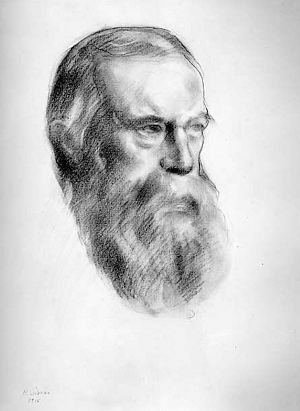
After 1900, Ryder's creativity slowed down a lot. For the rest of his life, he mostly worked on old paintings. Some of these paintings were just left around his New York apartment. Visitors to Ryder's home noticed his messy habits. He rarely cleaned, and his floor was covered with trash and old food. He would have to clear a spot for visitors to sit.
Ryder was shy and didn't often seek out other people. But he was polite to visitors. He enjoyed telling stories or talking about his art. He became known as a loner. However, he still kept in touch with friends. He liked writing letters and sometimes traveled to visit them.
Even though Ryder painted less after 1900, his fame grew. Important art collectors wanted his paintings. They often lent his best works to art shows across the country. Ryder himself had lost interest in showing his art. In 1913, ten of his paintings were shown in the famous Armory Show. This was a big honor. Modern artists of the time admired Ryder. They saw his work as an early example of modern American art.
By 1915, Ryder's health got worse. He died on March 28, 1917, at a friend's house where he was being cared for. He was buried in the Rural Cemetery in his hometown of New Bedford, Massachusetts. A special show of his work was held at the Metropolitan Museum of Art in New York in 1918.
Ryder's Art and Its Impact
Ryder finished fewer than 200 paintings in his life. Almost all of them were made before 1900. He rarely signed his paintings and never dated them.
Many artists from Ryder's time were forgotten later on. But Ryder's art stayed famous. This is because his style was so unique and ahead of its time. Artists like Marsden Hartley, who became his friend, and Jackson Pollock were influenced by Ryder's work.
Ryder used his paints in a very free way. He didn't always follow the best painting rules. He often worked on his paintings for ten years or more. He would build up layers of paint, resin, and varnish. He sometimes painted wet paint over wet varnish. Or he would put a fast-drying paint over a slow-drying one. He even used unusual things like candle wax and tar in his art.
Ryder's methods gave his paintings a special glow. His works seemed to "glow with an inner light." But this effect didn't last. Many of Ryder's paintings are now unstable and have become much darker. They have large cracks and sometimes don't dry completely, even after many years. Some have even fallen apart. Many of his paintings got worse during his lifetime. He tried to fix them in his later years. Some were worked on so many times that they are still soft today. Because of his own fixes, and because others finished or changed his paintings after he died, many of Ryder's works look very different now than they did when he first made them.
Fake Paintings
There are many fake Albert Pinkham Ryder paintings. Experts say there are more fake Ryders than almost any other American artist. They believe there are over a thousand fake Ryder paintings. Some of these fakes are even in private collections and museums. This happens because Ryder's style is fairly easy to copy.
People who make fake art might try hard to make a painting look old. They might paint on old canvas or even bake the painting to add cracks. Experts can find fakes by looking closely at the painting and testing its chemicals. They also check the painting's history. This means looking at written papers that show who owned the painting over time.
For example, a painting called Elegy was once thought to be a Ryder. It was on loan to the Whitney Museum. An expert named Lloyd Goodrich examined it. An X-ray showed that the painting had smooth, even brushstrokes. This was not typical of Ryder's layered style. It was decided that Elegy was likely a copy of a real Ryder painting called The Lone Horseman.
Selected Works
See also
 In Spanish: Albert Pinkham Ryder para niños
In Spanish: Albert Pinkham Ryder para niños
- History of painting
- List of Orientalist artists
- Orientalism
- Society of American Artists
- Tonalism
- Western painting





